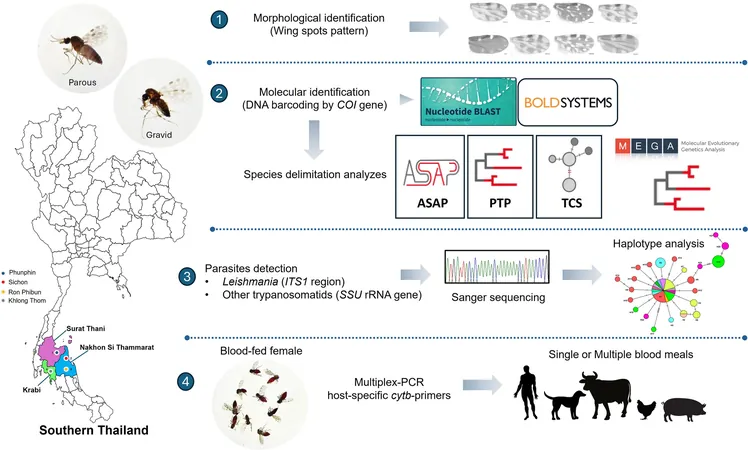
Unveiling the Hidden Threat: How Biting Midges Are Linked to Leishmaniasis in Southern Thailand
2025-05-29
Author: Jia
The Unseen Carriers of Disease
Biting midges, known scientifically as Culicoides, are tiny, blood-sucking insects that belong to the Ceratopogonidae family. With around 1,450 species identified worldwide, these pests are notorious not just for their irritation but for their role in spreading dangerous viruses like bluetongue and African horse sickness, impacting both livestock and humans. Alarmingly, they have now been implicated in the transmission of Leishmania, the parasite responsible for leishmaniasis, a serious public health concern in regions like southern Thailand.
Leishmaniasis: A Growing Public Health Crisis
According to a 2022 World Health Organization report, leishmaniasis is endemic in 99 countries, including Thailand. Here, both visceral leishmaniasis (VL) and cutaneous leishmaniasis (CL) pose significant health challenges, with cases on the rise due to ongoing transmission. Thailand is particularly affected, being home to species of Leishmania such as L. martiniquensis and L. orientalis, which necessitate urgent attention to understand their transmission dynamics.
New Discoveries in Vector Research
Recent research has spotlighted the role of biting midges as potential vectors for leishmaniasis, expanding the understanding of how this disease spreads beyond traditional sand flies. Laboratory studies reveal that the L. martiniquensis and L. orientalis species can be transmitted by Culicoides midges. Groundbreaking evidence from molecular surveys in northern Thailand has identified these parasites within midge populations, specifically in species like Culicoides mahasarakhamense.
Diverse Ecosystems: A Sampling in Southern Thailand
Field studies in southern Thailand—particularly in Nakhon Si Thammarat, Surat Thani, and Krabi provinces—have revealed alarming findings. Traps placed near livestock raised in communities with reported leishmaniasis cases collected over 875 midge specimens. Analysis showed that various midge species, especially Culicoides peregrinus and C. oxystoma, tested positive for Leishmania DNA, sparking concerns about their role as disease vectors.
DNA Barcoding: The Key to Identification
A significant breakthrough in the study of these biting midges is the application of DNA barcoding utilizing the cytochrome c oxidase subunit I (COI). This molecular technique allowed researchers to accurately identify Culicoides species amidst the backdrop of morphological complexities. The findings confirmed the presence of 25 different species, highlighting a rich biodiversity that requires ongoing monitoring.
The Complex Interplay of Hosts and Vectors
Analysis of blood meal sources from engorged midges revealed a predilection for cow blood, with some midges also feeding on dogs and even humans. This mammalophilic behavior raises critical questions about the role of domestic animals as reservoirs of leishmaniasis, highlighting the intricate web of interactions between vectors, hosts, and pathogens.
Towards Better Monitoring and Surveillance
The findings from this comprehensive analysis underscore the urgent need to monitor Culicoides populations and their transmission capabilities. With the rise in leishmaniasis cases and the complexity of vector dynamics, integrating traditional morphological methods with modern molecular techniques will be vital for effective surveillance and control strategies.
Conclusion: A Call to Action
As southern Thailand battles a growing leishmaniasis crisis, understanding the role of biting midges is crucial. The evidence linking these insects to disease transmission emphasizes the need for continued research and public health interventions. Protecting vulnerable populations from this hidden threat may well depend on unraveling the mysteries of these tiny yet impactful vectors.


 Brasil (PT)
Brasil (PT)
 Canada (EN)
Canada (EN)
 Chile (ES)
Chile (ES)
 Česko (CS)
Česko (CS)
 대한민국 (KO)
대한민국 (KO)
 España (ES)
España (ES)
 France (FR)
France (FR)
 Hong Kong (EN)
Hong Kong (EN)
 Italia (IT)
Italia (IT)
 日本 (JA)
日本 (JA)
 Magyarország (HU)
Magyarország (HU)
 Norge (NO)
Norge (NO)
 Polska (PL)
Polska (PL)
 Schweiz (DE)
Schweiz (DE)
 Singapore (EN)
Singapore (EN)
 Sverige (SV)
Sverige (SV)
 Suomi (FI)
Suomi (FI)
 Türkiye (TR)
Türkiye (TR)
 الإمارات العربية المتحدة (AR)
الإمارات العربية المتحدة (AR)